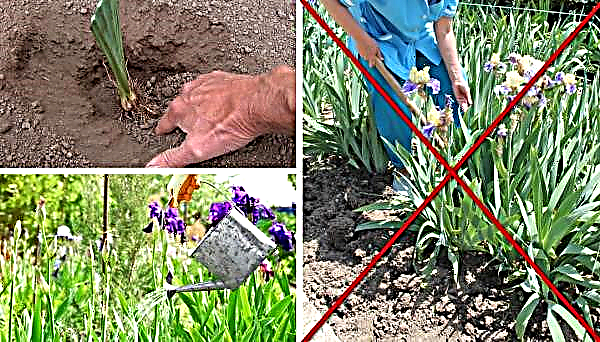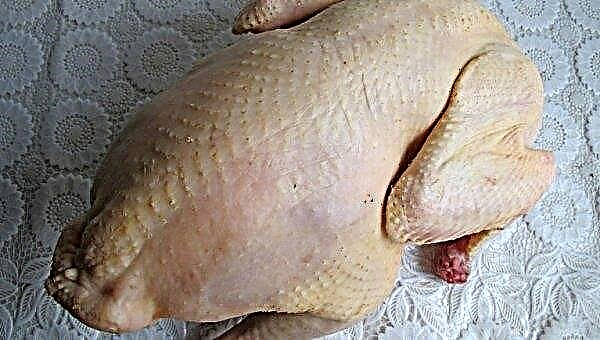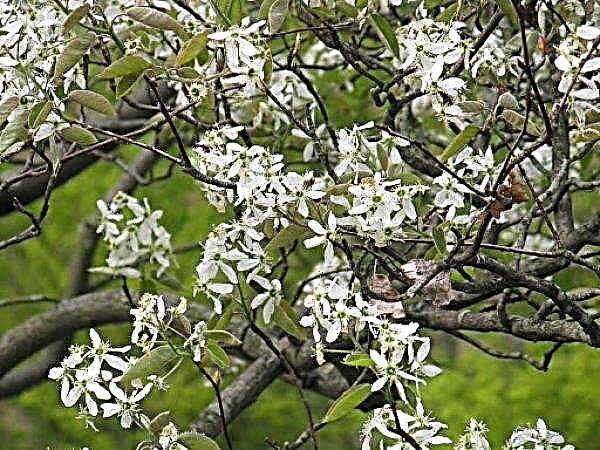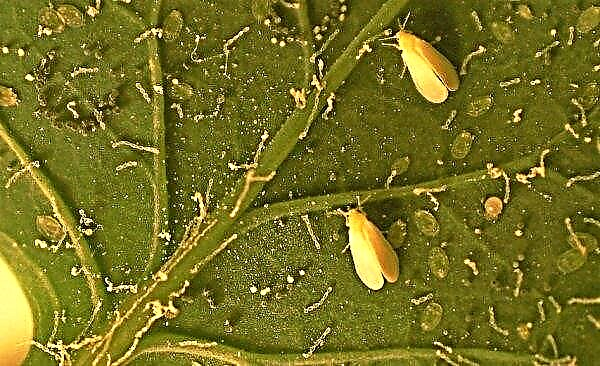Among the huge variety of indoor plants that can be purchased in flower shops today, perhaps the most unpretentious and simple to maintain are succulents. However, if someone finds the decorative properties of ordinary cacti very doubtful, in this category of drought-tolerant and easy-care flowers you can find much brighter and more interesting specimens, for example, stapelia, which will be discussed in this review.
Botanical description of the plant
Under natural conditions, stapelia grows in the mountainous, forest and floodplain areas of Africa (southern, southwestern, rarely eastern parts). This perennial succulent belongs to the Vetochnikovy family, also called Swallow or Lastovnev. It is believed that the name of the plant in 1737 was given by the doctor and natural scientist from Sweden, Karl Linney, thus perpetuating the name of his Dutch colleague Johannes Bodeus van Stapel.
As a houseplant, stapelia is grown mainly due to unusual and very effective flowers. Because of their shape and structure, the succulents are sometimes popularly called the "Order Star" or "Fluffy Starflower".
However, pleasing with its beauty of eyes, this unique flower is capable of causing the exact opposite reaction of another sense organ, namely, touch.
The botanical description of the slipway is given in the table:Did you know? The aroma of flowering stocks resembles the smell of rotten meat or fish (as the English say “bad fish”) that the main pollinators of this flower are carrion flies, flying to it like bees on honey, and even laying eggs inside a flower cup. Scientists believe that it was precisely to attract African flies of the Calliphoridae family that the plant developed such an unpleasant odor during evolution.
| Maximum sizes | 100-600 mm |
| Root system | Small, poorly developed |
| The stalks | Strongly branching and numerous, with creeping lateral shoots. They have the shape of four-, five- or hexagon with large teeth located along each rib. The structure of the stems is juicy, fleshy, without pubescence. Color is green, gray-green or reddish-green. |
| Leaves | Are absent |
| Inflorescence | Single or double, formed on the pedicel at the base of a young shoot, bending down |
| Flower shape | Five-pointed star or five-petalled bell with a “crown” rising above the petals. Petals usually have the shape of a triangle with a sharp peak |
| Color structure | Smooth or pubescent, fleshy |
| Color sizes | 5–300 mm |
| Coloring flowers | Dark red, brown, yellow-brown, yellow-green, variegated |
| Fruit | Up to 200 mm in length, two-horn form, with a large number of winged seeds. Not edible |
Views
Scientists know more than a hundred varieties of stapelia, but among the most famous and spectacular it should be mentioned, first of all, such:
- Stapelia asterias masson (Star-shaped stapelia) is a low, up to 200 mm, plant with green stems covered with small cloves. With a large amount of light, the stems can acquire a red-violet hue. Flowers of a star-shaped curved shape of dark red color with yellow spots (near the subspecies Stapelia asterias Masson var. Lucida, or Stapelia are shiny, there is no yellow color in the color of the flowers), they differ in the presence of long white hairs along the edges and pink villi in the center. Petals are a little bent. The dimensions of the flower are quite large - from 5 to 8 cm.

- Stapelia variegata (Variable stapelia, or variegated) is an even smaller variety of succulent, in height it can reach 50-100 mm. The stems are thin, in the slice they have the shape of a tetrahedron with rounded corners. The flowers are large, the same sizes as those of Stapelia asterias Masson, but the color is partridge - black ripples on a light brown background. Unlike the previous variety, in Stapelia variegata the flower is flat, but not smooth, but wrinkled. It was Stapelia variegata that apparently first came to Europe and began to be grown as a houseplant and garden plant. It happened at the beginning of the seventeenth century.
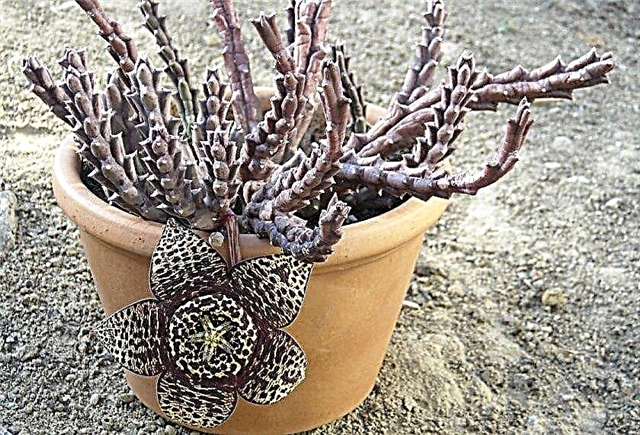
- Stapelia glanduliflora (Iron-flowered stapelia) is a relatively short perennial with strong stems standing upright, reaching 100–150 mm in height and 30 mm in thickness. The edges are clearly defined, the teeth are small and rare. During the flowering period, from 1 to 3 flowers bloom with a diameter of up to 50 mm. Coloring of flowers is yellow-green with pink partridge. Petals are covered with transparent villi in the center and white, longer along the edges. The shape of the flowers is star-shaped, flat.

- Stapelia grandiflora Masson, or obscura, or spectabilis (Stapelia is large-flowered, or Grandiflora) is one of the most popular varieties of the plant, valued for the almost complete absence of an unpleasant odor, as well as the ability to create decorative and lush thickets of velvety structure of stems, covered with bending denticles and having a beautiful greenish-red color. Grandiflora forms one or two huge, up to 150-200 mm in diameter, heavily dropped purple flowers from the front of the petals and blue-green from the back. The villi are gray, in some areas raised, in others pressed. In the early days, the petals are in the same plane, then bend back. In total, flowering lasts from three to five days.
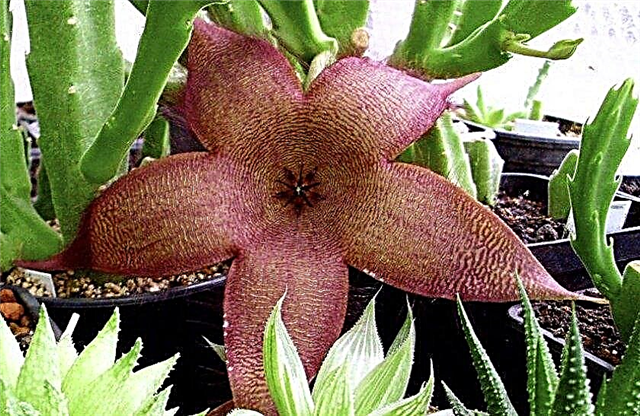
- Stapelia gigantea (Gigantic stapelia) is another species whose unpleasant odor is not so pronounced. In height, the stems can reach 200 mm, in thickness - up to 30 mm. Flowers are even larger than those of Grandiflora, up to 350 mm in diameter. On one plant, one to two buds are revealed. The color of the flowers is lemon yellow, the petals are deeply dissected, bent back. The pubescence is strong, and the contrasting red villi in the center give the flower a special decorative effect. White hairs along the edges of the flower.

- Stapelia hirsuta (Hairy stapelia) is distinguished by a violet-beige color of flowers and the presence of yellow blotches on the petals and a dark red edge. The size of the flowers is quite large, in diameter up to 100 mm.

- Stapelia flavo-purpurea (Golden purple stapelia) is a low succulent native to Namibia, not growing above 100 mm. The stems are green with a red tint, the flowers are located in the upper part. With small, up to 40 mm in diameter, sizes, up to three colors can be opened at the same time. Petals have a smooth structure and a bright yellow color (the inside is sometimes red). The lack of hairiness is compensated by decorative wrinkles, which can be yellow or red. A distinctive feature of the species is a fairly tolerable aroma, similar to the smell of wax.

- Stapelia mutabilis, She is neglecta Tod or fascata hort, in the Russian version - Stapelia is changeable. It reaches a height of 150 mm, the stems are distinguished by a bare structure and powerful teeth bent upwards. Flat flowers have the main yellow-green color, on which dark stripes and blotches are randomly arranged. The central “crown” is contrasting brown, pointed at the end. The sizes of the flowers are quite large - up to 70 mm in diameter. Stapelia mutabilis is a hybrid, but not artificially bred, but natural.

According to some reports, today there are about 70 different hybrid forms of slipway.Important! Most often, not natural varieties of stapelia, but its hybrids are grown as indoor plants, and for breeding, breeders most often use Stapelia hirsuta and Stapelia grandiflora, due to their high decorativeness and lack of a characteristic aroma.
House growing conditions
Like all succulents, the Order of the Star needs a lot of light and limited watering. But to ensure a spectacular and long flowering, you need to observe a certain number of conditions.
Lighting
Although the slipway should be attributed to photophilous plants, direct sunlight, especially midday, can be detrimental to it and cause burns, so it is best to place the flower near the windows facing the west or east side, or, if the south window is selected for the pot, in hot summer days use blinds or curtains for shading.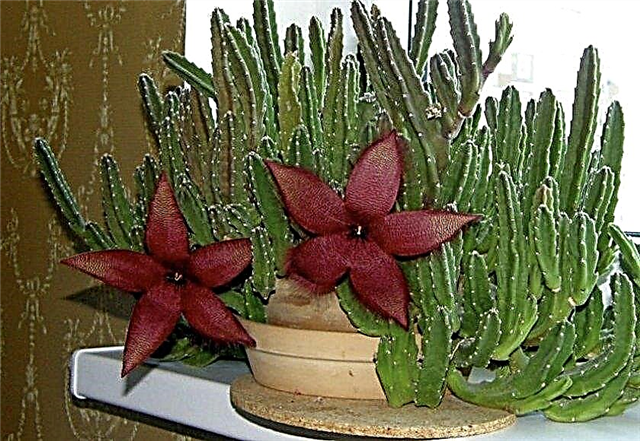 Experienced flower growers also recommend using light-shielding materials to adapt the flower to bright light in spring, after the plant has been at rest for a long time and has "lost the habit" of long "sun baths".
Experienced flower growers also recommend using light-shielding materials to adapt the flower to bright light in spring, after the plant has been at rest for a long time and has "lost the habit" of long "sun baths".
Ventilation
For most indoor plants, regular ventilation is a way to at least slightly humidify the air in the room, which becomes especially important with the start of the heating season. A “fluffy starflower” usually does not suffer from excessive dryness, but it reacts very well to airing. In addition, such procedures are sometimes necessary to weaken the miasma, the appearance of which is accompanied by the flowering of this succulent.
In summer, the flowerpot with the "Order of the Star" can be put on the open balcony or even taken out onto the street. Unlike many other flowers, stapelia is not afraid of drafts (not surprising, because this flower often grows in the mountains, where the winds are quite strong).
Temperature mode
Stapelia is a heat-loving flower, and yet we must not forget that it does not apply to tropical plants.
It is such a regime that should be considered optimal for the slipway, changing, of course, the places of winter and summer.Did you know? In South Africa, home to the Order of the Star, the climate is not as hot as it might seem. The average temperature there in winter ranges from + 18 ... + 27 ºC, while in summer the thermometer shows from +7 to +10 ºC.
Air humidity
Succulents prefer dry air to wet air, and the Order of the Star is no exception. Neither the spraying nor the additional moistening of the stapelia does not need, which compares favorably with tropical or subtropical indoor plants, for which it is very difficult to create suitable humidity in an urban apartment. Moreover, such procedures for the "Order of the Star" are harmful and can lead to the development of various fungal infections, loss of decorativeness and lack of flowering.
How to care at home
It’s easy to take care of the “Order Star”, you just need to properly water the plant, prevent soil depletion and periodically transplant the flower into a larger flowerpot.
Watering
Succulents rarely need to be watered, and the regularity of this procedure directly depends on the season and air temperature.
Earthen lumps should be completely dry during breaks between irrigation. In order to prevent the root system from decaying, during the growing season (mid-February - mid-September), an average of two irrigations per month is sufficient for the plant, at rest (the rest of the year) this amount should be reduced by at least half.Important! The cooler the room, the less watering should be.

For watering, you must use soft water, the temperature of which should be a couple of degrees warmer than the air in the room.
All succulents need to be watered along the edges of the flowerpot, preventing the soil from eroding at the roots, and also avoiding moisture entering the stems and flowers.
Top dressing
Stapelia needs to be fed very metered: an excess of fertilizer for a plant can be more dangerous than their lack. These procedures should be carried out exclusively during the period of active growth and not more often than twice a month.
We recommend that you familiarize yourself with the features of growing other succulents:Flower shops present a wide range of complex fertilizers for succulents, which are great for the "Fluffy Starflower". Examples of such drugs include:
- "Gilea" for cacti;
- "Stimulus" for cacti;
- FertiMix biohumus for cacti and other succulents;
- “Scotts Everis”;
- Planton Cat;
- "Planton K";
- "Fertis NPK 4.3.8";
- "Arvi Fertis."
 With the independent selection of mineral substances for feeding, emphasis should be placed on potassium and the amount of nitrogen should be limited, especially during the period of expected flowering. In addition to these elements, the composition of the fertilizer should also include calcium, phosphorus, magnesium and fluorine, which will provide the plant with rapid growth and a dense structure of the stems.
With the independent selection of mineral substances for feeding, emphasis should be placed on potassium and the amount of nitrogen should be limited, especially during the period of expected flowering. In addition to these elements, the composition of the fertilizer should also include calcium, phosphorus, magnesium and fluorine, which will provide the plant with rapid growth and a dense structure of the stems.Transfer
A large number of stems, which forms a stapelia, necessitates its periodic transplantation, otherwise the plant will cease to bloom in a tight pot. In the first 3-4 years of life, the Order of the Star must be transplanted every spring, older plants can be in the same pot for 2-3 for three years in a row, but after that the capacity still needs to be increased. In addition, even in the absence of a transplant, the topsoil in the pot with the onset of the active growth phase must be removed and replaced with fresh.
For the superficial and weak root system of the Order of the Star, a deep pot is not needed, but in order for the plant to grow better, a flowerpot with wide edges is perfect.Important! Unlike other indoor plants, when transplanting a slipway, it is not enough just to transfer it to a new pot with an earthen lump. Removing the flower from the flowerpot, you should remove the central (located in the middle of the bush) shoots: since the flowers of the plant are formed only on young stems, the old ones, pulling out the vital juices, interfere with active flowering.
Video: Stapeli transplant
Prepared flowerpot at least a third must be filled with drainage material, and only then fill the soil. The basis of the substrate for Stapelia should be sand, which is mixed with two parts of sod land, and also lightened, disinfected and fed with a small amount of charcoal. Additionally, in order to disinfect the finished substrate, it is necessary to pour it abundantly with a weak solution of potassium permanganate. It’s even easier to buy a soil mixture for succulents in a flower shop.
After placing the plant in a new pot over the earthen coma, add the necessary layer of soil and compact it well to give the flower stability. The transplanted succulent must be kept without watering for at least three days, so that the root system has time to gain a foothold.
How to propagate
The easiest way to propagate the "Order Star" by rooting cuttings, but the seed method is also suitable.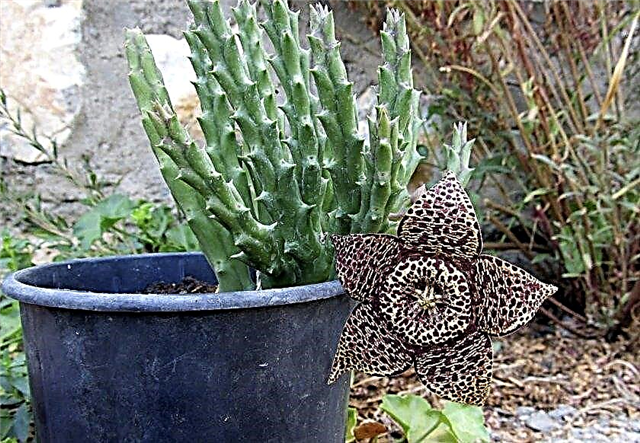
Cuttings
Young shoots are cut off from an adult plant with a sharp knife, after which they immediately sprinkle the cut (both on the cuttings and on the parent plant) with chopped charcoal to prevent the development of infection. The resulting processes are dried for several hours in a well-ventilated place and buried in prepared containers (boxes, boxes, cassettes for seedlings) filled with a mixture of sand and peat.
There is no need to cover the cuttings with a film, since excessive humidity of the air to the succulent is more likely to hinder than to help. Rooting takes place quickly, literally in 7-10 days, if you put the boxes in a sunny warm place.Important! Putting the cuttings in water so that it takes root is a gross mistake when it comes to succulents.
 After a young plant starts up several young shoots, it can be transplanted to a permanent place in an individual pot with ordinary soil for cacti and after a year and a half to wait for the appearance of flowers.
After a young plant starts up several young shoots, it can be transplanted to a permanent place in an individual pot with ordinary soil for cacti and after a year and a half to wait for the appearance of flowers.Seeds
The seed method of stapelia propagation is inconvenient in that its fruits ripen for a very long time. So, the box that forms on the site of the flower remains green for about ten months and only after that it begins to gradually turn into a kind of pod, turn yellow and crack. When this happens, you need to collect the seeds and remove from them the fluff with which they are covered.Then the material is pickled by soaking in a weak solution of potassium permanganate and seeded with a slight indentation into a moistened substrate, consisting of peat and river sand mixed in equal proportions.
Important! Planted from the seeds of stapelia bloom no earlier than two or three years later.
For better germination, the containers should be covered with a film and set in a bright place with an air temperature of + 20 ... + 25 ºC. If the procedure is carried out correctly, almost every seed gives seedlings. You can expect the appearance of sprouts in a week or two. Then the film should be removed. The transplantation of young succulents into individual pots up to 100 ml in volume with the usual soil for a flower is carried out when the plant reaches 5 cm. When choosing the method of propagation of the “Order of the Star”, one should take into account its variety: if we are talking about hybrid flower forms, several completely different plants can grow from the seeds, and not one of them will correspond to the mother.
When choosing the method of propagation of the “Order of the Star”, one should take into account its variety: if we are talking about hybrid flower forms, several completely different plants can grow from the seeds, and not one of them will correspond to the mother.
Growing difficulties
Despite the fact that the “Order of the Star" refers to unpretentious succulents, certain problems with its cultivation may occur. In most cases, they are associated with improper care, to which the plant responds with diseases or lack of flowering.
Does not bloom
The main purpose of growing an African plant is its unusual flowers, so if they do not appear, this cannot but upset.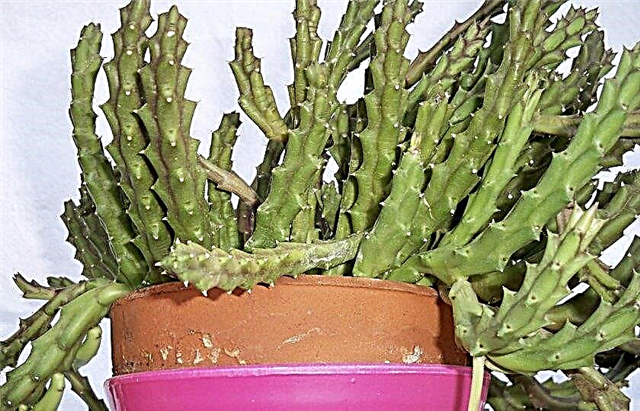 There are several most likely reasons why this problem occurs:
There are several most likely reasons why this problem occurs:
- Violation of the alternation of phases of development and rest. For all flowering indoor plants, it is important to ensure good rest in the cold season, then with an increase in daylight, they will be ready for intensive growth and abundant flowering. During the dormant period, the flower should be placed in a cooler place, to minimize watering and stop feeding. If this condition is met, next summer flowers will certainly appear.
- Excessive humidity. Succulents are able to store water in their own tissues for a long time, which is why they can grow in arid regions and for a long time do without rain. This means that spraying and frequent heavy watering for such flowers is unnatural, and the absence of flowering is a common reaction to adverse conditions.
- Lack of light. Since the birthplace of the Order of the Star is sunny Africa, this plant will not bloom in the shade and penumbra. The yellowing of the stems and the lack of a red tint in their main color may also indicate that flower problems are associated with insufficient lighting.
- Unsuccessful soil composition. In nature, stapelia grows on stony and loamy soils, so if you plant it in a heavy substrate with an alkaline reaction, the succulent will hurt, while only healthy plants always bloom.
- Violation of the rules of feeding. The "Order Star" does not tolerate both insufficient and excessive fertilizing, in addition, if the imbalance in the application of fertilizers is directed towards the nitrogen component, this will stimulate increased stalk growth to the detriment of bud budding.
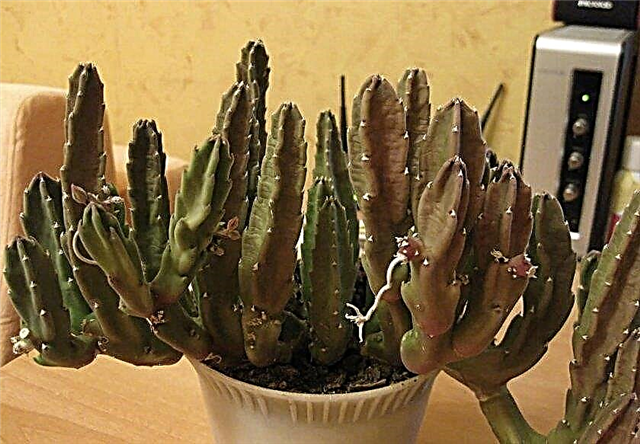
Diseases and Pests
Among other problems that the owner of the Order of the Star may encounter are:
- fungal infections. We can talk about root or stem rot, which is associated with excess moisture (in the air or in the soil) or overcooling of the plant. In advanced cases, the flower can be lost, so it is important to take measures in time: stop watering or spraying, raise the air temperature, transplant the flower into a container with a good drainage layer, if necessary - treat it with a systemic fungicidal preparation;
- burns on the stems. They arise from direct sunlight, are treated by shading and removal of damaged fragments;
- stretching up, pale color of the stems. Usually due to depleted soil or lack of light;
- stunting. May occur due to too tight a pot (should be transplanted plant) or lack of fertilizer in the substrate.
As for pests, they infect hardy and unpretentious stocks quite rarely.
But if the plant is sick due to improper care or is in close proximity to other infected indoor flowers, it can be attacked by parasites such as:
- spider mite;
- mealybug;
- aphid.
 The parasites themselves or traces of their vital activity can be easily found on green stems (these can be spider line-like threads, sticky streaks or dark spots). At the first sign of damage, the plant must be washed carefully with a saturated soapy solution, you can also use water diluted with alcohol, garlic or onion juice.
The parasites themselves or traces of their vital activity can be easily found on green stems (these can be spider line-like threads, sticky streaks or dark spots). At the first sign of damage, the plant must be washed carefully with a saturated soapy solution, you can also use water diluted with alcohol, garlic or onion juice.If alternative methods have not yielded results, the flower should be treated with an insecticide (for damage by aphids or mealybugs) or acaricide (for damage with a spider mite), or better, a systemic drug.
For this purpose, you can use, for example, tools such as:
- Fitoverm;
- "Decis";
- Inta-Vir;
- "Fufanon";
- "Actellicus."
Omens and superstition
Despite the fact that special signs and superstitions are not connected with the slipway, the incredible combination of magnificent flowers and the disgusting stench, and most importantly, the truly diabolical ingenuity shown by the African plant to attract pollinating insects, cannot but give rise to various speculations and mystifications among esoteric lovers.
So, for example, they say that:Did you know? The great German writer I.V. Goethe, being in Holland and walking through one of the local botanical gardens, was so struck by the imbalance between the appearance and aroma of the slipway that he called this succulent the most beautiful and at the same time the most monstrous flower in the world.
- the more flowers unfold on the slipway, the more negative energy reigns in the house (that is, the plant feels as comfortable as possible in an atmosphere unsuccessful from the point of view of mutual understanding and love);
- variegated varieties of the flower are well suited for those who are used to violently argue and conflict, uncompromisingly defending their opinion: with such a person, the plant successfully establishes the exchange of energy prone to contradictions, as a result of which both the flower and its host seem to nourish each other with vital force;
- the lack of leaves in the succulents helps to curb excessively talkative, impulsive and mobile people who do not know how to control their emotions: next to the "Order Star" such households should become calmer, the flower will set them up for silent contemplation of the world;
- “Fluffy starflower”, not being disposed to noise and fun, has the property of braving friends and guests from home, although this does not apply to truly close people;
- it is very useful to put the slipway into the room where the difficult teenager lives, in this way it can be saved from committing rash acts and falling into a bad company;
- the plant is a good gift for those who like to read a lot, with such an owner the "Order Star" will easily enter a state of harmony;
- succulents help to achieve success in creativity, strengthen the will and feel inspiration, as well as get rid of bad habits;
- stapelia increases sexuality - both male and female, and also positively affects reproductive function.
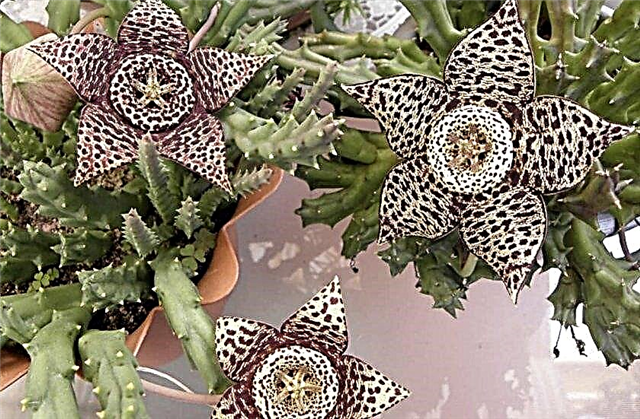 Stapelia is a unique plant in which nature was able to combine the most beautiful and disgusting features, but it is this amazing contrast that attracts a huge number of flower growers to an unusual succulent. Caring for it is not at all complicated, so the only dilemma that should be solved before buying such a flower is the willingness or unwillingness to put up with its truly monstrous aroma for the pleasure of admiring the fabulous beauty of flowers.
Stapelia is a unique plant in which nature was able to combine the most beautiful and disgusting features, but it is this amazing contrast that attracts a huge number of flower growers to an unusual succulent. Caring for it is not at all complicated, so the only dilemma that should be solved before buying such a flower is the willingness or unwillingness to put up with its truly monstrous aroma for the pleasure of admiring the fabulous beauty of flowers.











